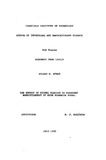JavaScript is disabled for your browser. Some features of this site may not work without it.
| dc.contributor.advisor | Robinson, M. J. | |
| dc.contributor.author | Evans, Juliet M. | |
| dc.date.accessioned | 2009-03-04T15:20:11Z | |
| dc.date.available | 2009-03-04T15:20:11Z | |
| dc.date.issued | 1992-07 | |
| dc.identifier.uri | http://hdl.handle.net/1826/3238 | |
| dc.description.abstract | The microstructure of high strength steel is susceptible to delayed failure caused by the absorption of hydrogen produced either during cathodic charging or electroplating. When 0.8%C and AISI 4340 steel are subjected to constant load testing, a wide range of failure times is observed. By applying Weibull statistics small changes in experimental parameters such as heat-treatment are detected readily and are explained in the terms of hydrogen trapping at microstructural defects. During the electroplating of steel in a double-cell, quantitative measurements are made of the amount of hydrogen permeated. Current densities are measured in the range 2- 40 mAcm2 and it is shown that, although the lowest current density produces the most mechanically sound plate, it also causes the largest amount of hydrogen absorption. The nickel deposit is found to act as a reservoir for reversibly trapped hydrogen allowing diffusion to continue into the steel after the cessation of plating. Permeation measurements were taken on AISI 4340 steel using an electrochemical probe developed from the Barnacle Electrode. The effects of cathodically charging and electroplating with nickel are compared. Exposure of the steel to the atmosphere is shown to have an important influence on the hydrogen content after a period of time due to a limited occurrence of corrosion. Various post- plating treatments are commonly used to remove a damaging concentration of hydrogen and the quantitative effects of such treatments are described. Finally, a mathematical model is proposed which explains the reason for the wide spread of delayed failure times. It is found that if the stress intensity necessary to initiate a crack is known and, provided either the nominal stress or the crack size is known, it is possible to calculate either the allowable defect size or the allowable stress below which cracking is not expected to occur. | en_UK |
| dc.language.iso | en | en_UK |
| dc.publisher | Cranfield University | en_UK |
| dc.title | The Effect of Nickel Plating on Hydrogen Embrittlement of High Strength Steel. | en_UK |
| dc.type | Thesis or dissertation | en_UK |
| dc.type.qualificationlevel | Doctoral | en_UK |
| dc.type.qualificationname | PhD | en_UK |
